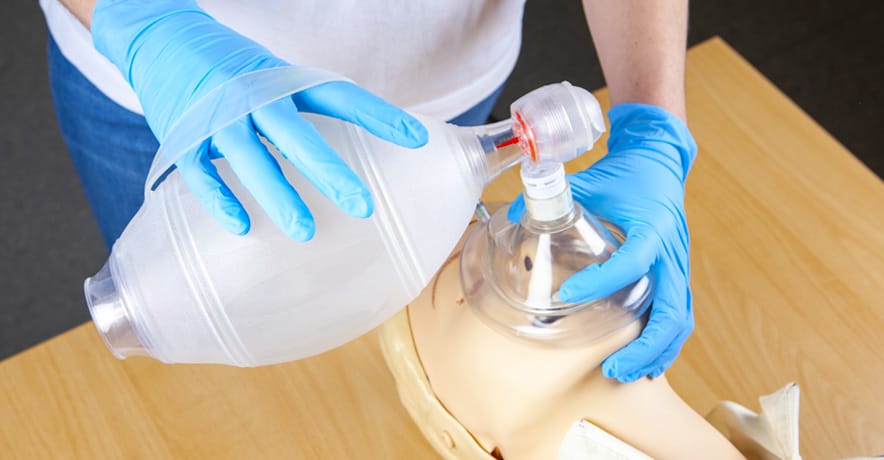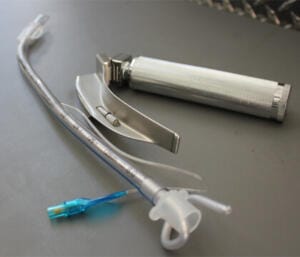4 Ways to Deliver Rescue Breaths

Today we are going to be talking about four different ways that you can give rescue breaths to a person.
What are Rescue Breaths?
Rescue breaths are given when somebody needs assistance with ventilation. Usually, it is not that they are not breathing, just that their breathing is depressed or not adequate to support life. Assistive ventilations must be given because without adequate oxygenation your brain loses 10 percent every minute it goes without oxygen.
Mouth to Mouth
There are four different ways that we can deliver breaths. The first way is mouth to mouth which is usually what people think of when they think of giving breaths. Mouth to mouth is something most people have seen and heard of. Some people even get this technique confused with CPR, as it can be a part of performing CPR.
To give ventilations mouth to mouth, you should pinch the nose to keep air from escaping that way, tilt the head back to open the airway and then give breaths mouth to mouth. While doing this, you will be looking to see the victims chest-rise. As soon as you see any kind of chest-rise, stop and then give a second breath.
You are supposed to give breaths every 5-6 seconds for infants. However, for children and adults you are looking at one breath every 2-3 seconds. This best replicates the normal respiratory rate of people.
The mouth to mouth technique is usually only suitable in the absence of airway protection (discussed below). However, we do not recommend it if there is somebody that you do not know because of the potential of communicable diseases.
Pocket Masks
The next best way to deliver ventilations is with the use of a pocket mask. Pocket masks often come in little, hard case containers that can be stored anywhere like your car, home, office, or anywhere you have a first aid kit or AED. They retail for around $8 and usually include gloves and a sanitizing wipe with them.
To use the pocket mask, you will first pop them up to put the valve into position. The valve is one way and prevents any kind of secretions or bodily fluids from coming back up. Essentially, you can blow into the mask but nothing can come out.
To put the mask in position, you will take the narrow part (top of the triangle shape) of the mask and place it on the bridge of the nose pushing down. Take your index finger and thumb and push down on all four corners of the mask. Then you will take your other three fingers and grab the forehead, then grab the chin and tilt back. Next, you blow air into the mask while looking for chest rise. As soon as you see the chest rise you stop. You do not want to over inflate or over oxygenate.
Bag- Masks
The next method of giving ventilations is one that you are not going to usually see or have access to unless you work in a healthcare. The use of a bag mask is generally the most popular way of giving ventilations for anyone in a healthcare position. The bag valve mask can also connect to oxygen allowing victims to receive a higher concentration of oxygen. Additionally, the use of this device gives you a little bit more space from the patient.
Bag masks are used from the head of the patient; not from the side. Similar to a pocket mask, you will place bridge of the patients nose at the narrow part of the mask. Next, you will grab your hand and cup it all the way around the face and the mask while tilting the head back. While giving a breath you look for the victims chest to rise. Usually half a squeeze of the bag is all that you need to use to get sufficient chest rise. Additional air does not help the victim but can over oxygenate and cause hyperventilating.
Bag Masks come in adult, child, and infant sizing. However, an adult bag mask *could* be used on any size person, it’s just generally not advised. These cost around $15 and can purchased on CPR Supply Source for professional or training use.
ET’s (Endotracheal Tube’s)
The final tool that can be used for assistive ventilations is an ‘ET’ or endotracheal tube. These are probably going to be used more in a hospital setting. Sometimes paramedics will use these in their ambulance. An ‘advanced airway’- an ET tube or endotracheal tube – can go into the mouth and give a direct airway into the trachea.
When you are delivering air with a bag, pocket mask, or mouth to mouth breaths, air is going to more places than just the victims lung. A little bit of air is going into the stomach and a little bit is going into the lungs. However, when you use one of these it really isolates the airflow directly into the lungs.
Training
It’s advised to only perform methods of ventilations that you have received training in. A basic CPR class will teach how to do mouth to mouth breaths as well as how to use a pocket mask. A Healthcare provider CPR class will teach how to do breaths via mouth to mouth, with a pocket mask, and with a bag mask. For training on ET’s, most people will take specialized courses as well as complete Advanced Cardiac Life Support and Pediatric Advanced Life Support.
To find a local class near you on training in giving breaths, please visit Class Eagle. Class Eagle is a free health and safety instructor directory that will connect you with a professional instructor in your area.



